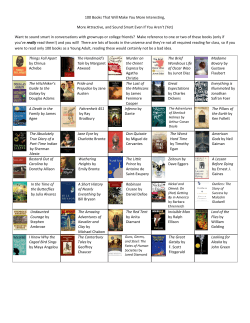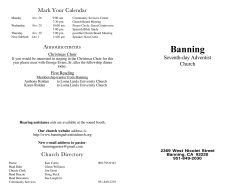
Grid Computing: What Is It, and Why Do I Care? Ken MacInnis
Grid Computing: What Is It, and Why Do I Care?* Ken MacInnis <ken.macinnis@gmail.com> * Or, “Mi caja es su caja!” (c) Ken MacInnis 2004 1 Outline Introduction and Motivation Examples Architecture, Components, Tools Lessons Learned and The Future Questions? (c) Ken MacInnis 2004 2 What is “grid computing”? Many different definitions: Utility computing Cycles for sale Distributed computing distributed.net RC5, SETI@Home High-performance resource sharing Clusters, storage, visualization, networking “We will probably see the spread of ‘computer utilities’, which, like present electric and telephone utilities, will service individual homes and offices across the country.” Len Kleinrock (1969) The word “grid” doesn’t equal Grid Computing: Sun Grid Engine is a mere scheduler! (c) Ken MacInnis 2004 3 Better definitions: Common protocols allowing large problems to be solved in a distributed multi-resource multi-user environment. “A computational grid is a hardware and software infrastructure that provides dependable, consistent, pervasive, and inexpensive access to high-end computational capabilities.” Kesselman & Foster (1998) “…coordinated resource sharing and problem solving in dynamic, multiinstitutional virtual organizations.” Kesselman, Foster, Tuecke (2000) (c) Ken MacInnis 2004 4 New Challenges for Computing Grid computing evolved out of a need to share resources Flexible, ever-changing “virtual organizations” High-energy physics, astronomy, more Differing site policies with common needs Disparate computing needs Utility computing provides cycles only when needed (c) Ken MacInnis 2004 5 Traditional Architecture United Kingdom User Petabyte Storage Washington Michigan 2 Glasgow 5 4 Computation 1 3 6 7! Visualization London United States (c) Ken MacInnis 2004 6 Grid Architecture United Kingdom Petabyte Storage User (web) Michigan Washington 1) SOAP, XML, GSI Web Portal Server Texas Computation Glasgow GridFTP, GSI GRAM, XML, MDS, GSI XML, GridFTP, SOAP Visualization London United States (c) Ken MacInnis 2004 7 Outline Introduction and Motivation Examples Architecture, Components, Tools Lessons Learned and The Future Questions? (c) Ken MacInnis 2004 8 Examples Project Description AccessGrid Group collaboration, distance learning DOE Science Grid General purpose resource sharing TeraGrid NEESgrid GridMP Global iVDGL UK e-Science Distributed “Terascale” computing Earthquake analysis United Devices computational projects International physical science German research grid projects UK collaboratory backbone Enterprise Grid Alliance Commercial grid development Fraunhofer Resource Grid (c) Ken MacInnis 2004 9 CERN Large Hadron Collider Computing Grid 12-14 petabytes data per year Equivalent of 70,000 desktop computers 6000+ users, 100s of institutions Filters @ 100-200MB/s CERN 2.5-10 Gb/s (Tier 0/1) USA Japan UK Center 2 .. .. .. .. .. PC Storage Viz PC PC Cluster 2.5-10 Gb/s (Tier 2) Center 1 1-10 Gb/s Cluster Storage (c) Ken MacInnis 2004 10 (c) Ken MacInnis 2004 11 Example – Electronic Arts Electronic Arts, “Sims Online” Grid supporting 250k players 30,000 SQL calls per second per cluster Backend is scalable with player count Inherently highly available (c) Ken MacInnis 2004 12 Outline Introduction and Motivation Examples Architecture, Components, Tools Security Globus Data movement Condor, MPI Web portals Lessons Learned and The Future Questions? (c) Ken MacInnis 2004 13 Architecture – Software Tools and Components Security: X.509 Toolkits: Globus Toolkit 2.x Globus Toolkit 3.x+ Job Scheduling: Condor, Condor-G Parallel Programming: MPICH-G2 (c) Ken MacInnis 2004 14 X.509 Security Public/private certificate system 1. 2. 3. 4. User creates private certificate, and public certificate request Certificate Authority verifies user’s identity Certificate Authority provides a signed response (public certificate) to request Any site with CA’s public key can now verify user’s ID (chain of trust) Does not require pre-staging a public key, i.e. SSH Grid Security Infrastructure (GSI) proxy can then be used as a “placeholder” Single sign on Impersonation / delegation (c) Ken MacInnis 2004 15 X.509 Security cont. Certificate Authority is the atom of trust Each Virtual Organization may have >=1 CA No single CA can compromise all certificates Each CA can belong to multiple Virtual Organizations Your Distinguished Name [DN] is your Grid ID Remote site performs DN-UID mapping at will Trust revocation Each CA publishes Certificate Revocation List [CRL] Online Certificate Status Protocol (OCSP) responders (c) Ken MacInnis 2004 16 Globus 2.x - Motivation Globus is today’s de-facto grid toolkit Also only toolkit implementation (well, almost) Provides many of the “Grid” protocols Open source, open framework! Builds on Linux, FreeBSD, Mac OS X, even Tru64! Windows? (c) Ken MacInnis 2004 Portability is a problem. 17 The Globus Toolkit 2.x in One Slide Grid protocols (GSI, GRAM, …) enable resource sharing within virtual orgs; toolkit provides reference implementation ( = Globus Toolkit services) MDS-2 (Meta Directory Service) Reliable remote GSI User invocation Gatekeeper Reporter (Grid (registry + (factory) Security Authenticate & discovery) Infrastruc- create proxy Create process Register credential ture) User process #1 Proxy User process #2 Proxy #2 GRAM (Grid Resource Allocation & Management) (c) Ken MacInnis 2004 Slide source: Globus Alliance Soft state registration; enquiry Other GSIauthenticated remote service requests GIIS: Grid Information Index Server (discovery) Other service (e.g. GridFTP) 18 Globus 2.x – What’s Right Strong security implementation GSI provides good delegation support Traditional supercomputing works well Built for “jobs” and “clusters” High-speed data transfer Excellent base for further community development PyGlobus, (c) Ken MacInnis 2004 GridFTP clients, etc. 19 Globus 2.x – What’s Wrong First pass at a “Field of Dreams”: Not everything is clusters and jobs: sensors, instruments, networks, databases The “whole system” is left out of the picture Large and complex to install and support End users cannot configure on their own Lots of memory leaks C and Perl (c) Ken MacInnis 2004 20 Globus 3.x Globus Toolkit 3 introduced Grid Services Grid services == Web services with state Open Grid Services Architecture (OGSA) Protocols and formats Open Grid Service Infrastructure (OGSI) WSDL specifications defining standard interfaces, behaviors, and schema implementing OGSA Java, (c) Ken MacInnis 2004 .NET (as well as C/C++) 21 Globus 4.x Globus Toolkit 4 introduces WSRF Web Services Resource Framework “Web services for grid computing” Announced Jan 2004 Collaboration of Globus Alliance, IBM, HP, Akamai, SAP, others. Industry backing shows the Grid is here to stay! (c) Ken MacInnis 2004 22 Data Movement – GridFTP High performance, secure, reliable data transfer built on FTP Features built for distributed systems: GSI security on control and data channels Multiple data channels for parallel transfers Partial file transfers Third-party (direct server-to-server) transfers Authenticated data channels Reusable data channels Command pipelining (c) Ken MacInnis 2004 23 Data Movement - GridFTP Existing FTP clients Normal FTP clients simply add GSI authentication Full-featured clients include third-party transfers, additional transfer modes, extra features Upcoming features Java rewrite (server was based on wuftpd) Striped data transfers (c) Ken MacInnis 2004 24 Data Movement – SRB/MCAT Storage Resource Broker, Metadata Catalog “A uniform interface for connecting to heterogeneous data resources over a network and accessing replicated data sets.” Provides additional tools for: Collaboration High performance movement Backing storage awareness C, C++, Java, Perl, Python bindings What is SRB? SRB is a Distributed File System SRB is a Data Grid Management System SRB is a Digital Library SRB is a Semantic Web (c) Ken MacInnis 2004 25 Data Movement – Globus RLS Replica Location Service Provides access to logical names for data items to target names Example: Distributed databases can have multiple repositories RLS provides mapping to closest location (c) Ken MacInnis 2004 26 Condor - Motivation Modern computing is highly distributed Most desktops are lightly loaded ZZZZZ zzzz … Little use: typing documents, reading email No use: at a meeting, overnight, vacation We should harness these wasted cycles! Cycle Scavenging (Cycle Sucking) (c) Ken MacInnis 2004 27 Condor – The Fundamentals Condor is a distributed computing job manager Metrics: Keyboard use, load, time of day User-definable, highly expandable Checkpointing: Suspend, restart, move Set of daemons on each workstation allows for job management User returns to keyboard, job fails, etc. Condor-G (Grid): Submission front-end to Grid resources Meta-scheduling! Maintains credentials (auto-renewal, etc.) Crash-resistant: Persistent state allows for graceful error recovery (c) Ken MacInnis 2004 28 Condor – Summary Condor’s benefits: Flexible cycle sucking to utilize all resources Integrates with non-Condor Grid resources Advanced workflow and check pointing tools Portable: Windows, UNIX, Java support Condor’s drawbacks Configuration is mystifying to the neophyte No source (yet) -- promised (c) Ken MacInnis 2004 29 MPICH-G2 MPI – Message Passing Interface MPICH-G2 is grid-enabled MPI v1.1 GSI security Distributed job startup Heterogeneous architectures In other words: Grid-enabled group resources can compute as one MPI Except: High-latency (c) Ken MacInnis 2004 interconnect now! 30 Web Portals Web portal definition: Loosely integrated features bundled into an efficient, common interface presented through an accessible medium (the WWW) Examples: Yahoo is more than just a search engine: games, finance, mail, more! (c) Ken MacInnis 2004 31 Web Portals - Motivation Grid tools are too difficult to maintain: Installation, maintenance, upgrades Globus is truly one of Dante’s nine rings Also want Consistent interface No prerequisites past a web browser One stop shopping Access anywhere (c) Ken MacInnis 2004 32 Web Portals - Example Personalized Mail (c) Ken MacInnis 2004 33 Web Portals - Technology OGCE: Open Grid Computing Environment Java-based Grid Portal toolkit framework Supports job and credential management (MyProxy) Supports GridFTP and Condor-G Extensible The NSF supported grid portal project Requirements: Java, Tomcat, and Jetspeed Why a framework? Frameworks allow for rapid prototyping One portal will not meet all needs, thus.. Multiple portals for multiple projects (c) Ken MacInnis 2004 34 (c) Ken MacInnis 2004 35 (c) Ken MacInnis 2004 36 (c) Ken MacInnis 2004 37 (c) Ken MacInnis 2004 38 Tools summary – Globus Toolkit Globus 2.x great for “traditional supercomputing” Pioneered many protocols, still widely used Globus 3.x introduced service model Globus 4.x well-backed in industry WSRF, (c) Ken MacInnis 2004 Grid Services 39 Tools summary – Data Movement GridFTP provides FTP compatibility with GSI authentication, third-party transfers, high performance SRB/MCAT provide resource brokerage services as well as metadata cataloging RLS is an efficient data replication service (c) Ken MacInnis 2004 40 Tools summary – Condor, MPICH-G2 Condor High performance distributed computing via cycle scavenging Availability metrics Multi-platform checkpointing Lots of additional neat tools: DAGMan, Condor-G MPICH-G2 Harness multiple MPI resources as one High latency, tough configuration, single programming model (c) Ken MacInnis 2004 41 Tools summary - Windows Using Windows in grid computing: Portals are key Condor can harness computational power (cluster-ize) Globus grid services are now available for Windows, but no “old-style” services (c) Ken MacInnis 2004 42 Outline Introduction and Motivation Examples Architecture, Components, Tools Lessons Learned and The Future Questions? (c) Ken MacInnis 2004 43 Political Challenges Unsolved problems are politically-based Purpose-built grids are successful “Field of Dreams” does not work here, yet Users are set in their ways Federation in Certificate Authorization, e.g. Grid technology is a big change requiring a paradigm shift! Virtual Organization partner relationships Security response policies, compromises, software stacks Who is responsible for what? Many “bosses” (c) Ken MacInnis 2004 44 Political Challenges cont. Security is hard: GSI helps this as a single base, but: Common authentication Accounting CA policy Cross-site trust is hard! No solutions yet. Why political? “Grid” security is just security + X.509 Rough spots are in the inter-realm areas (c) Ken MacInnis 2004 45 Technical Challenges Software stacks: Common base of interoperable software Synchronized upgrades? Support: Is problem local or remote? How does user tell? Network issues: No one group to control commodity network between Standards The Global Grid Forum Lots of proposed standards, loosely collected No O’Reilly / Dummies books here! (c) Ken MacInnis 2004 46 Words of Advice Policy first! Make sure everyone is in agreement “Fire plan” (playbook) especially important Agree on software policies as well as versions Define goals to meet “Grid Computing” is task oriented, not a general provision (c) Ken MacInnis 2004 47 So, What Is The Grid, Then? “The Grid” is a collection of applications, protocols, policies, and procedures which allow collaboration to occur in an efficient manner It’s everywhere! Modern systems have global aspirations Design with extensibility in mind (c) Ken MacInnis 2004 48 And Why Do I Care? Collaboration is the name of the game Use unused resources efficiently Tragedy of the Commons Resource sharing is new key to funding Most importantly.. It’s a state of mind! Get into the habit of building resources with “The Grid” from the beginning. (c) Ken MacInnis 2004 49 Summary What is Grid? Common protocols allowing large problems to be solved in a distributed multi-resource multi-user environment. Why Grid? Exponential increase in computing needs Collaboration extremely important Modern Grids Industry/academia, large/small, focused/utility (c) Ken MacInnis 2004 50 Summary cont. Grid architecture Security X.509 certificates GSI Tools Globus 2.x, 3.x, 4.x Web/Grid Services Condor, MPI / MPICH-G2 Web portals Data movement (c) Ken MacInnis 2004 51 Summary cont. Challenges Political challenges Technical challenges Advice Start early Policy Well-defined goals (c) Ken MacInnis 2004 52 Questions? Ken MacInnis ken.macinnis@gmail.com (c) Ken MacInnis 2004 53
© Copyright 2025









